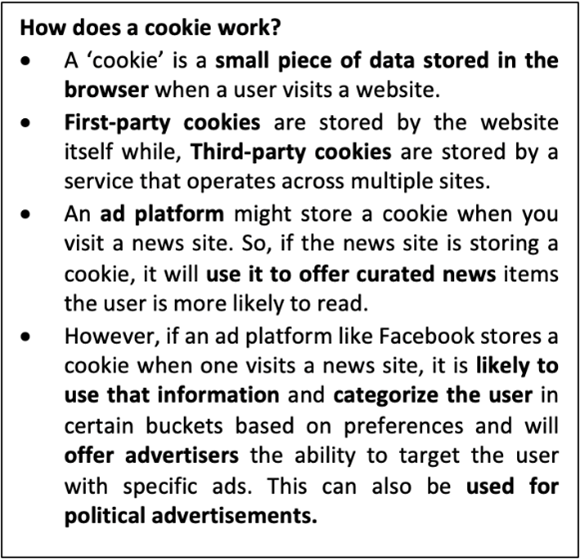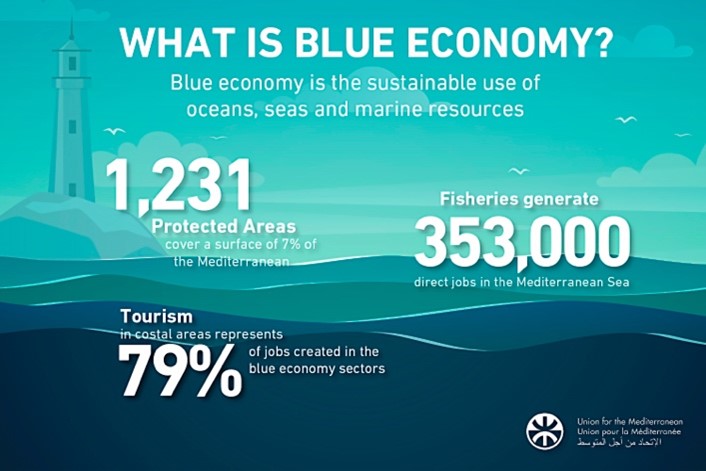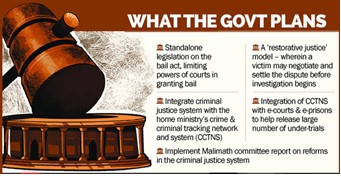Friday, 25th February 2022
Scheme of Border Infrastructure and Management
In News
The Centre has recently approved the continuation of the central sector umbrella scheme of Border Infrastructure and Management till 2025-26.
About the News
- The scheme is aimed at strengthening and improvingborder infrastructure and management in addition to policing and guarding the borders.
- The scheme will help in the creation of infrastructures such as the construction of border fences, border floodlights, technological solutions, border roads and border outposts (BOPs) and company operating bases (COBs) to secure the Indo-Pakistan, Indo-Bangladesh, Indo-China, Indo-Nepal, Indo-Bhutan and Indo-Myanmar borders.
- The cost of the scheme will be Rs 13,020 crore.
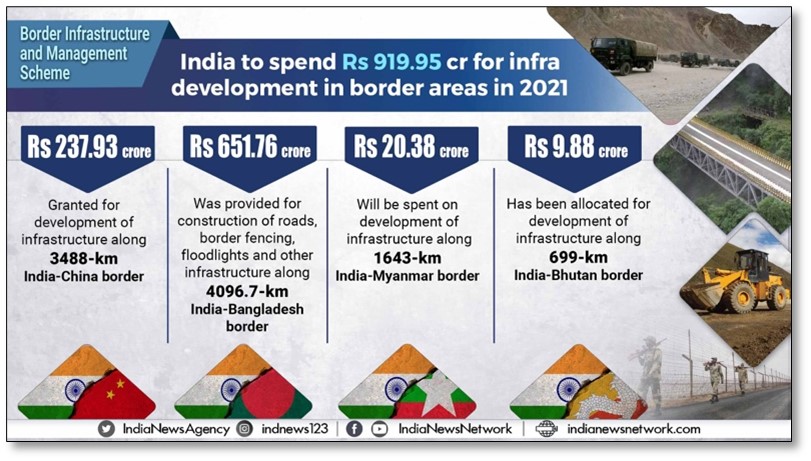
Other Initiatives to Secure Borders
- Smart Fencing in India (CIBMS): CIBMS involves deployment of state-of-the-art surveillance technologies such as thermal imagers, infra-red and laser-based intruder alarms, aerostats for aerial surveillance etc to secure riverine borders.
- Border Road Organization:
- Founded in 1960, BRO plays a major role in providing defence infrastructure such as roads, bridges, highways, airports, tunnels, buildings etc.
- It has constructed lifelines of over 53,600 km for the people of North-Eastern States, Ladakh, Jammu & Kashmir, Himachal Pradesh and Andaman & Nicobar Islands.
- Vibrant Villages Programme:
- Northern border villages with sparse population, limited connectivity and infrastructure that get left out from the development gains such as housing, tourist centers, road connectivity, etc are covered under this initiative.
- The move has been taken to counter the Chinese 'model villages' close to the LAC (Line of Actual Control)
- The Border Area Development Programme (BADP):BADP ensures balanced development of border areas through development of infrastructure and promotion of a sense of security among the border population.
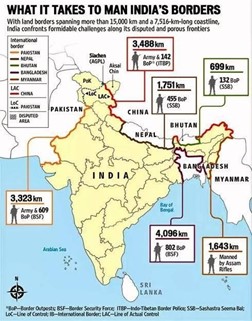
Source:
- Govt approves Rs 13,020 cr for Border Infrastructure and Management
- Central sector umbrella scheme to continue for border infrastructure and management till 2025-26
Image source:
Integrated Plant Nutrition Management Bill, 2022
In News
The Union government has released draft bill to control distribution, price, quality of fertilisers
About the News
- Ministry of Chemicals and Fertilizers has recently released the draft Integrated Plant Nutrition Management Bill, 2022 to empowers it to fix the maximum selling price of fertilisers and control its quality as well as distribution.
- The bill aims to promote the development and sustainable use of balanced fertilisers, including bio-fertilisers, bio-stimulates, nanofertilisers and organic fertilisers to sustain India’s food and nutritional security without causing adverse harm to the quality of the environment and health of the soil.
- It will also support the welfare of farmers while promoting the optimal yields of crops in India which will promote India’s mission of AatmaNirbhar or self-sufficiency.
What are the major proposals under the bill?
- Price Management of fertilisers: The Central Government to fix the maximum prices or rates at which any fertiliser may be sold by a dealer, manufacturer, importer or a fertiliser marketing entity.
- No dealer, manufacturer importer or fertiliser marketing entity shall sell or offer for sale any fertiliser at a price exceeding the maximum price or rate fixed under this clause.
- Restriction on the sale and use of fertilisers: No person shall himself, or by any person on their behalf, manufacture, import for sale, sell, offer for sale, stock, exhibit for sale or distribute any fertiliser which does not meet the standards as may be provided for under this Act, rules and regulations made thereunder.
- Import: All imports of articles of fertiliser to be subject to this Act with no person shall import into India—any spurious or misbranded or sub-standard fertiliser; Any product containing fertiliser for the import will require licence or registration.
- Genetically modified bio-fertilisers or bio-stimulants: No person shall carry on the business of preparing, manufacturing, distributing, selling or importing any genetically modified bio-fertiliser or bio-stimulant without the prior approval of the Central
- Enforcement of this Act: The Authority, the Central Government and the State Government shall be responsible for the enforcement of this Act with Central Government to take Suo motu cognizance in case of any irregularities in the actions of manufacturers, dealers or retailers under this Act and to initiate action for inquiry.
- Offences under this Act: Any manufacturer who fails to comply with laboratory requirements that are specified by way of regulations issued by the Authority under this Act, shall be liable to have its certificate of registration of manufacture cancelled and shall be punishable with a fine which may extend to ten lakhs rupees.
For articles related to this topic, refer:
https://edukemy.com/current-affairs/kosmos/2022-02-05/soil-health-management
https://edukemy.com/current-affairs/gazette/2021-09-01/sukhet-model
Sources:
Crude Oil Prices in India amid Ukraine Crisis
In News
The Russia-Ukraine tension and the consequent surge in crude oil prices pose a risk to the financial stability of the country and the government is closely monitoring the situation.
Why are Crude Oil Prices getting affected?
- Russia is a key supplier of energy globally, third-largest oil producer and second-largest oil exporter.
- Europe relies on Russia for about a quarter of its oil supplies and a third of its gas.
- Crude oil prices are now hovering at around a 7-year high, with Brent oil prices surging above $100 a barrel for the first time since 2014.
- It is being speculated that the crude oil market is likely to see sustained higher prices in the next quarter, before retreating to an average of $90 at the end of the year.
- Even though there is no interruption in oil supply, the shooting of prices is due to the geopolitical risks and also the potential worry about the supply and leading to buying to fill the storage.
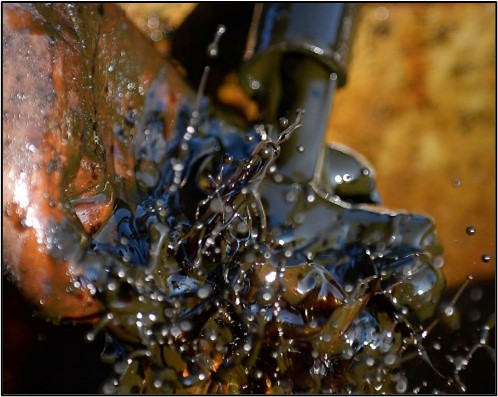
What may be the impact on India?
India imports 80 per cent of its crude oil needs. But since Indian refineries cannot process the heavy crudes that Russia exports & the transportation costs from Russia to India is high, India buys very little oil and gas from Russia. But the economy may be affected due to global rise in prices in the following ways:
- Rise in pump prices, LPG: One of the first and foremost impact may be the jump in petrol, diesel prices in India.
- The petrol and diesel prices have remained stable since November 2021, and a price rise is expected.
- Impact on inflation: According to a 2019 RBI study, a $10 per barrel increase in crude oil prices could have a direct impact of 24 basis points of CPI inflation and an indirect impact of 26 basis points of CPI inflation.
- Rupee depreciation: Sustained foreign fund outflows, heavy selling in domestic equities and elevated crude oil prices may weigh on investor sentiment leading to FPI outflow. Thus, Rupee depreciation may be seen in the near future
- Impact on deficit position: High international oil prices, has the capacity to disrupt India's balance of payment situation at a time when the current account deficit has already widened.
- According to a Reserve Bank of India study in 2019, every $10/barrel increase in crude prices on an annual basis, leads to an additional $12.5-billion deficit.
- It has the potential to increase the country's expenditure and affect the fiscal deficit position adversely.
- Growth: Should higher oil prices impact inflation and lower disposable spending, growth could see an impact as well.
- GDP growth in the July-September quarter of the current fiscal was at 8.4%. However, growth rates in recent quarters have been distorted by base effects due to the pandemic.
Way Forward:
- Forex reserves with RBI, at present, are at $630 billion. Even in terms of imports, the cover provided by forex reserves is at over 10 months of total imports using the last available data.
- This is a much better position for the economy that 2014, when crude oil process had last hit the three-figure mark.
- Even with higher oil imports and FPI outflows, RBI will have enough to cushion the effect of the oil shock.
- To stem the inflation, government may choose to lower excise duties on fuel products.
- RBI may opt to raise rates more than the two hikes expected in August-December 2022 to keep control the CPI inflation.
For articles related to this topic, refer:
https://edukemy.com/current-affairs/gazette/2021-10-08/global-energy-crisis
https://edukemy.com/current-affairs/gazette/2021-11-24/strategic-oil-reserves
https://edukemy.com/current-affairs/gazette/2021-07-12/opecs-output-pact-proposal
Sources:
India taken off polio endemic list
On February 25, 2021, India was taken off polio endemic list by WHO. Only two polio-endemic countries (nations that have never interrupted the transmission of wild poliovirus) remain—Afghanistan and Pakistan. Of the three serotypes of wild poliovirus, type 2 was certified as eradicated in 2015 and type 3 was certified as eradicated in 2019. India rolled out the Pulse Polio Immunization Programme on 2 October 1994, when the country accounted for around 60% of the global polio cases. Within two decades, India received ‘Polio-free certification’ from World Health Organization on the 27 March 2014, with the last polio case being reported in Howrah in West Bengal on 13 January 2011. Polio (poliomyelitis) mainly affects children under 5 years of age, with 1 in 200 infections leading to irreversible paralysis. Among those paralysed, nearly 5% die when their breathing muscles become immobilized.

Source:
Free Trade Agreements
In News
Recently, India and the United Arab Emirates (UAE) signed a Free Trade Agreement (FTA), which is set to reduce tariffs for 80 per cent of goods and give zero duty access to 90 per cent of India’s exports to the UAE.
What is a Free Trade Agreement?
- FTAs are arrangements between two or more countries or trading blocs that primarily agree to reduce or eliminate customs tariff and non-tariff barriers on substantial trade between them.
- FTAs, normally cover trade in goods (such as agricultural or industrial products) or trade in services (such as banking, construction, trading etc.). FTAs can also cover other areas such as intellectual property rights (IPRs), investment, government procurement and competition policy, etc.
- FTAs also provide criterion called the ‘Rules of Origin (RoO)’ which are required for the determination of product's country of origin for the imposition of the preferential tariff on international trade.
- FTAs act as an exception to the Most Favored Nation principle adopted by WTO (World Trade Organization). (Most Favored Nation (MFN) policy by WTO - As per Article 1 of General Agreement on Tariffs and Trade (GATT), member nations of WTO are prohibited to discriminate between their trading partners.)

Importance of FTAs in Foreign Trade
- By eliminating tariffs and some non-tariff barriers FTA partners get easier market access into one another's markets. Secondly, FTAs may also protect local exporters from losing out to foreign companies that might receive preferential treatment under other FTAs.
- Competition on a global level: FTAs encourages competition on a global level, increasing efficiency of domestic industries, specialization within countries, availability of cheaper and better-quality products for consumers.
- Enhanced global growth: FTAs help build shared ways to trade and investment and offer support for strong people-to-people and business-to-business links which in turn enhances global growth.
- More dynamic business climate: Without free trade agreements, countries often protected their domestic industries and businesses. This protection often made them stagnant and non-competitive on the global market. With the protection removed, they became motivated to become true global competitors.
- Expertise: Global companies have more expertise than domestic companies to develop local resources, especially in mining, oil drilling, and manufacturing. Free trade agreements allow global firms access to these business opportunities and training in the best practices.
- Technology transfer: Local companies also receive access to the latest technologies from their multinational partners. As local economies grow, so do job opportunities. Multinational companies provide job training to local employees.
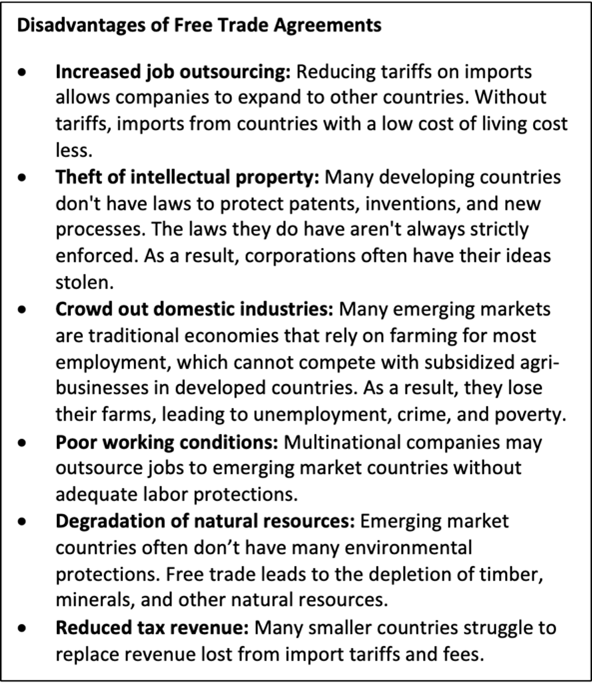
India’s FTA story
- Underperforming exports: Indian exports to FTA countries haven’t outperformed exports to the rest of the world. Also, India tends to import more and export less under FTAs, creating a trade deficit.
- Underutilization of trade pacts: India’s rate of FTA utilization is less than 25%. While developed countries utilization rate is 70%-80%. India’s low utilization rate can be attributed to a lack of awareness about FTAs and Rules of Origin, high cost of FTA compliance, non-tariff barriers in importing countries, and absence of industry in trade negotiations, among others.
- Blinkered vision: India’s trade agreements suffer from an over-emphasis on “market access” when they should be paying more attention to non-tariff barriers standing in the way of healthy trade. These barriers include differences over packaging and labeling requirements, the absence of mutual recognition of certificates, complicated trade financing and inadequate modernization of procedures.
- Lack of direction: India has signed the highest number of trade agreements with Asian countries. This might have caused it to neglect other markets with high trade potential. For example, most of the Indian trade in 2016 was with West Asia (35%) and Africa (32%).
- Spaghetti bowl effect: India’s Asia focus suffers from the “spaghetti bowl effect” – a phrase used to describe multiplication of FTAs. For example, India has separate CECAs with Singapore and Malaysia, which are also part of the larger India-ASEAN CECA.
What India is doing to strengthen its FTAs
India is aware of its failings and has, fortunately, taken some corrective steps. These include:
- Reviewing existing FTAs: India is in the process of reviewing its FTA with ASEAN. Its demands include removal of non-tariff barriers, better market access and stronger Rules of Origin provisions. Similarly, it has demanded a review of the CEPAs with South Korea and Japan.
- Strengthening Rules of Origin: The enforcement of CAROTAR 2020 is a step in this direction. CAROTAR requires an importer to satisfy himself that the importing goods meet the prescribed originating criteria and do basic due diligence before importing them.
- Going back to traditional markets: The market share of Indian exports in Asia has dropped in the past decade, despite a rash of trade agreements. At the same time, market share in traditional markets like the US and Europe has gone up from 38% to 43% in the same period, even though India does not have an FTA with either. As a step in the right direction, India and the UK launched an FTA as part of their ambitious Roadmap 2030 engagement.
- Into Africa: Africa holds immense potential for Indian trade. The India-Mauritius Comprehensive Economic Cooperation and Partnership Agreement is India’s first trade agreement with an African nation. It is expected to serve as a model for FTAs with other African countries.
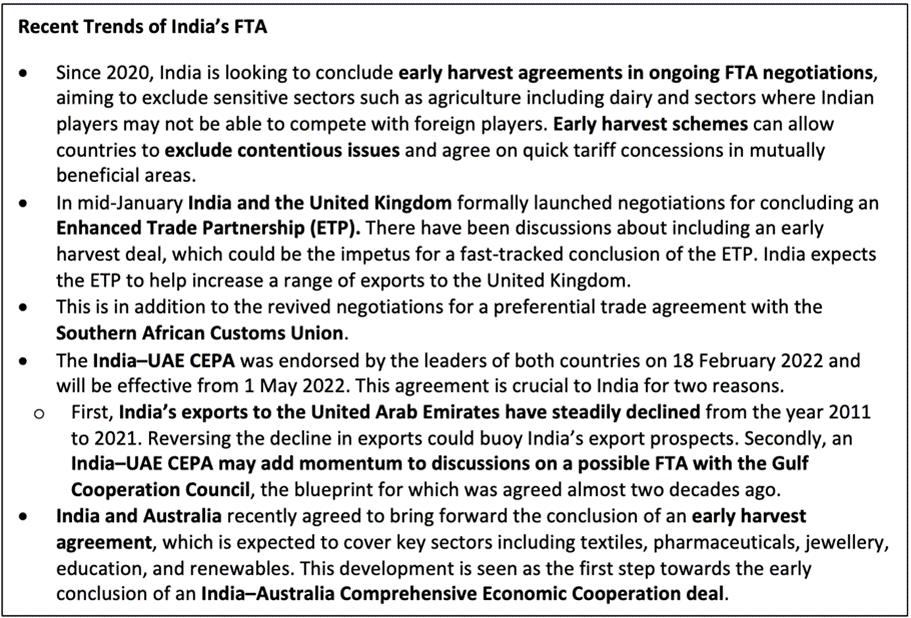
Way Forward
Trade agreements, including FTAs, can be extremely beneficial if done right. Here is what India can do to get a better deal:
- Sign new agreements only after conducting in-depth analysis and taking the opinions of all stakeholders on board
- Firm up safeguard clauses in FTAs, especially with regard to protecting domestic industries against import threats. This can be done, for example, by putting in a provision for a safeguard measure that can be invoked if a volume or price trigger for a certain product is reached
- Make the most of a post-Covid world where many countries are expected to search for markets beyond China to source goods and services from
- Improve India’s global competitiveness. Lowering transaction costs, encouraging foreign investment in infrastructure and research and development, improving ease of doing business are some ways to go about this.
For articles related to this topic, refer:
https://edukemy.com/current-affairs/gazette/2021-08-02/domestic-firms-and-ftas
https://edukemy.com/current-affairs/gazette/2021-09-02/30-years-of-1991-reforms-a-stocktake
Question: Discuss the importance of FTA in Foreign trade. Why has India not been able to utilize the full potential of FTAs.
Sources:
- Free Trade Agreements:
- Pros and Cons of Free Trade Agreements:
- India’s renewed embrace of free trade agreements:
- Foreign Trade Agreements Can Boost India’s Exports, If Done Right:
- CAROTAR 2020:
- India’s FTAs: What Hasn’t Worked? What’s The Change In Strategy?:
- India moving on early harvest agreements is good, but what is needed is FTAs:
India's first Biosafety Level-3 mobile laboratory
This is image of India's first Biosafety level-3 containment mobile laboratory, which was recently launched in Nashik, Maharashtra. It was launched by the Ministry of Health and Family Welfare. The mobile laboratory has been set up to investigate newly emerging and re-emerging viral infections. This laboratory will be able to access remote and forested areas of the country where specially trained scientists from ICMR can investigate outbreaks using samples from humans and animal sources. The laboratory has been designed and built by the Indian Council of Medical Research in collaboration with Mumbai based bio-safety equipment maker Klenzaids. This is the first Mobile BSL-3 Laboratory of South Asia region. Tthe laboratory is airtight, access-controlled, bio-decontaminable, fitted with safe change HEPA (High Efficiency Particulate Absorbing) filtration and biological liquid waste decontamination system. The lab is controlled through an intelligent control automation system, which maintains the working environment under negative air pressure, maintains equipment parameters and records all necessary data.
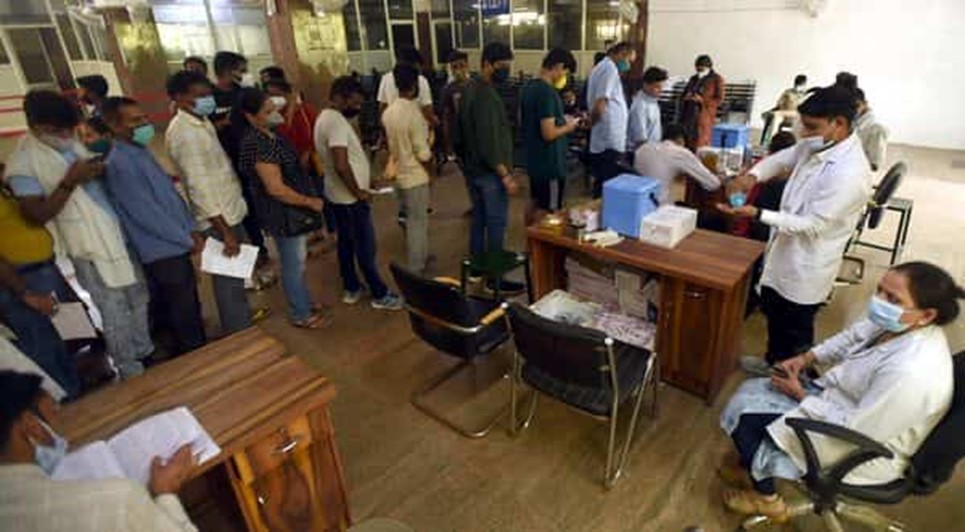
Source:
MILAN 2022
- Context:Exercise MILAN 2022 has begun recently in Vishakhapatnam, Andhra Pradesh.
- MILAN is a biennial multilateral maritime exercise conducted by the Indian Navy.
- The first edition of the exercise took place at the Andaman and Nicobar Islands in 1995.
- The purpose of the exercise is to fine-tune operational skills; discuss and pick up the best practices and procedures in use and enable a foundational base of learning in the maritime domain though interactions with peers from other countries.
- The navies of Vietnam, Myanmar, Malaysia, South Korea, Bangladesh and Indonesia, along with QUAD members will be participating in the exercise this year.
- The theme of this year’s edition is "Camaraderie – Cohesion – Collaboration" which aims to project India as a responsible maritime power to the world at large.
- The exercise will involve exercises in sea like surface, sub-surface and air domains and weapon firings.
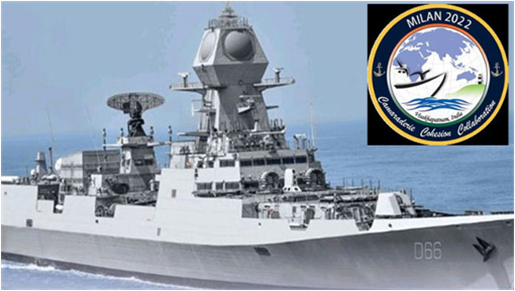
Source:
- Countering China: 13 nations including Bangladesh, Myanmar, Vietnam to participate with warships in largest-ever naval exercise Milan
- Indian Navy's multilateral exercise MILAN 2022 begins today: All you need to know
Image source:
Quantum Key Distribution test
- Context:The DRDO and IIT scientists have recently demonstrated Quantum Key Distribution (QKD) link between Prayagraj and Vindhyachal in Uttar Pradesh, a distance of more than 100 kilometres.
- QKD is a mechanism that utilises a cryptographic protocol involving various components of quantum mechanics to undertake secure communication.
- The technology enables two communicating sides to come up with random secret keys shared by both of them and known exclusively to them, so only they can use it to encrypt and decrypt messages, thus achieving a very highly-secure communication.
- Secure communication is important for defence and strategic agencies across the globe for which the distribution of encryption keys is a crucial factor.
- Sharing of keys over the air or wired links requires encryption, which in turn requires encryption keys to be pre-shared.
- Thus, Quantum-based communication offers a robust solution to sharing the keys securely.

Source:
- DRDO, IIT Delhi successfully demonstrate Quantum Key Distribution test
- DRDO and IIT Delhi scientists demonstrate Quantum Key Distribution between two cities 100 kilometres apart
Image source:
Illegal Trade of Sea Cucumbers
- Context: Illegal trade involving sea cucumbers in India has witnessed a sharp spike over the last five years.
- Sea cucumbers are echinoderms (worm-like sea creatures) that are single branched (invertebrates) with tubular bodies resembling a cucumber found on the sea floor.
- As they feed on the detritus in sediment, they help to recycle nutrients and excrete nitrogen, ammonia, and calcium carbonate, key ingredients for coral reefs. Their feeding also helps to slow the oceans’ acidification from human activity.
- They are an unusual class of animals but play a vital role in the ocean ecosystems.
- They are high in demand across Southeast Asia, especially China, for food and traditional medicine.
- They are Protected under Schedule I of the Wildlife Protection Act (WPA), 1972, and are listed as endangered species in IUCN Red List.
- The Ministry of Environment, Forests and Climate Change (MoEFCC) imposed a total ban on harvesting and transporting sea cucumbers in 2001.
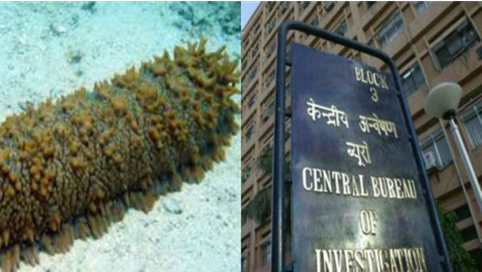
Source:
- ‘Aphrodisiac’ of the ocean: how sea cucumbers became gold for organised crime
- 13 times rise in quantity of sea cucumber seizures from India over five years: Study
Image source:
Star Campaigner
- Context:The Election Commission (EC) has recently restored the number of star campaigners a party can field for campaigning in elections as Covid cases have started declining.
- A star campaigner is a celebrity vote seeker in an election for a party.
- This person can be a politician or even a film star. There is no law governing who can or cannot be made a star campaigner.
- They are nominated by the concerned political parties specifying their constituencies and duration of the status.
- A ‘recognised’ party declared as such by the Election Commission can nominate a maximum of 40 star campaigners.
- Expenditure incurred on electioneering by the star campaigner is not added to a candidate’s poll expenditure giving him/her more leeway. According to the Representation of People’s Act, these expenses will be borne by the political parties.
- However, when a prime minister or a former prime minister is star campaigner, the expenditure incurred on security including on the bullet-proof vehicles will be borne by the government.

Source:
- Assembly polls: EC restores number of star campaigners as Covid cases decline
- Covid-19 cases decline, EC restores star campaigners' limit in Assembly polls
- Who is a star campaigner? Why is this status significant in elections?
Image source:
Introduce digital media literacy in schools: HT
Essence: Recent research identified a lack of focus on digital media literacy in educational policy as a key element in the propagation of online misinformation such as social polarisation, vaccination reluctance, and real-life violence, among other things. We need policy-driven ways to curb and manage the spread of disinformation on social media platforms– First and foremost, social media outlets must be regulated. However, such interventions are laden with political repercussions since individuals in most liberal democratic cultures are wary of government interference in their right to free expression. Second, individuals, particularly schoolchildren, should be taught social media literacy so that they can navigate the information they get on these platforms.
According to a survey performed in several countries, including India, digital media literacy programmes for school students have helped them distinguish between reliable material and misinformation/fake news. The National Education Policy 2022 of the Indian government is a squandered chance to include media literacy in the curriculum. However, deciding on a school curriculum is a contentious political issue. It's just as critical to provide folks with the knowledge and skills they'll need to manage the huge amounts of information that will be poured through social media. Incorporating digital media literacy programmes into school curricula is a critical policy intervention for preparing responsible future citizens and upholding democratic norms in the digital age.
Why should you read this article?
- To understand the how lack of digital media literacy is a key element in spreading online misinformation.
- To know what possible steps can be taken to address the issue and how Incorporating digital media literacy programmes into school curricula is a critical policy intervention.
Source:
Shaking Up Europe’s Security Architecture: TH
Essence: The editorial highlights the broken security architecture of Europe and how the major stakeholders are reacting to the hangover from the cold war era. Firstly, USA and other NATO countries violated the agreement on non-expansion of NATO further east in Europe. Next, even when there was no ideological conflict, USA kept forcing the NATO and influenced politics to engage deeply with Ukraine, which possibly led to Crimean annexation. Varied interpretation and implementation of Minsk accords infuriated the tension. It eventually resulted in the offensive from Russia’s end.
Europe involves in trade with its neighbor Russia and with recently imposed sanctions, energy security, transactions, mobility would get restricted, furthering the fragmentation. For the same reason, countries like France and Germany have been engaging with Russia separately. While the world focuses on Europe, India must remain vigil at Indo-Pacific region to withstand any misadventure from the regional hegemon China.
Why should you read this article?
- To understand the economic crisis and fragmentation in Europe.
- To know the background of the present turmoil between Ukraine and Russia.
Source:
Ploughing a new channel for India’s food systems: TH
Essence: India is facing the challenge of achieving nutrition security for its population while struggling at the same time to arrest declining land productivity and ensure sustainability. It is important to realize that instead of focusing on “agriculture” in isolation, it is time to focus on the complete “food system”. Goal should also be widened to include sustainability and nutrition security along with food security.
Author argues that capacity building of farmers, incentivising them to promote sustainability and supporting business growth in the rural economy is at the center of the transformation. These efforts should be backed by cutting edge research and creation of robust infrastructure and institutions.
Why should you read this article?
- To appreciate that goals of food and nutrition security and sustainability are interlinked.
- To understand steps which need to be taken to achieve these goals.
- To get some relevant data for enriching your answers in GS paper 3 and Essay.
Source:
Self-respecting wedding
Background
- Marriage ceremonies and their rituals happen to reflect some orthodox elements of the society like patriarchy, caste divide and so on.
- But Nivetha and Yatharth has set an example by not only discarding the traditional norms but also the outlook of their wedding.

About the Couple’s Couple’s Self-Respecting Wedding
- Coming from different parts of the country and community, atheism and like-mindedness brought them together.
- When they decided to get married, the one thing that came to their mind is the rituals that would take place in the wedding.
- They finalised on EV Ramasamy Naicker (Periyar)’s self-respecting marriage which is known as suyamariyathai or Thamizh in Tamil.
- These marriages are held typically between inter-caste couples and the rituals that are performed are non-patriarchal in nature.
- The Brahminical customs and traditions are not performed here, while the marriage is officiated by elders of the couple.
- Periyar introduced this concept of marriage under the Self-Respect Movement as it supported equality between men and women along with a caste-free society.
- In Tamil Nadu, this marriage practice is legalised under the Hindu Marriage Act.
Quote: ‘Everyone has the right to refuse any opinion. But no one has the right to prevent its expression.’- E.V. Ramasamy Naicker
Source:
Share the article
Get Latest Updates on Offers, Event dates, and free Mentorship sessions.

Get in touch with our Expert Academic Counsellors 👋
FAQs
UPSC Daily Current Affairs focuses on learning current events on a daily basis. An aspirant needs to study regular and updated information about current events, news, and relevant topics that are important for UPSC aspirants. It covers national and international affairs, government policies, socio-economic issues, science and technology advancements, and more.
UPSC Daily Current Affairs provides aspirants with a concise and comprehensive overview of the latest happenings and developments across various fields. It helps aspirants stay updated with current affairs and provides them with valuable insights and analysis, which are essential for answering questions in the UPSC examinations. It enhances their knowledge, analytical skills, and ability to connect current affairs with the UPSC syllabus.
UPSC Daily Current Affairs covers a wide range of topics, including politics, economics, science and technology, environment, social issues, governance, international relations, and more. It offers news summaries, in-depth analyses, editorials, opinion pieces, and relevant study materials. It also provides practice questions and quizzes to help aspirants test their understanding of current affairs.
Edukemy's UPSC Daily Current Affairs can be accessed through:
- UPSC Daily Current Affairs can be accessed through Current Affairs tab at the top of the Main Page of Edukemy.
- Edukemy Mobile app: The Daily Current Affairs can also be access through Edukemy Mobile App.
- Social media: Follow Edukemy’s official social media accounts or pages that provide UPSC Daily Current Affairs updates, including Facebook, Twitter, or Telegram channels.


